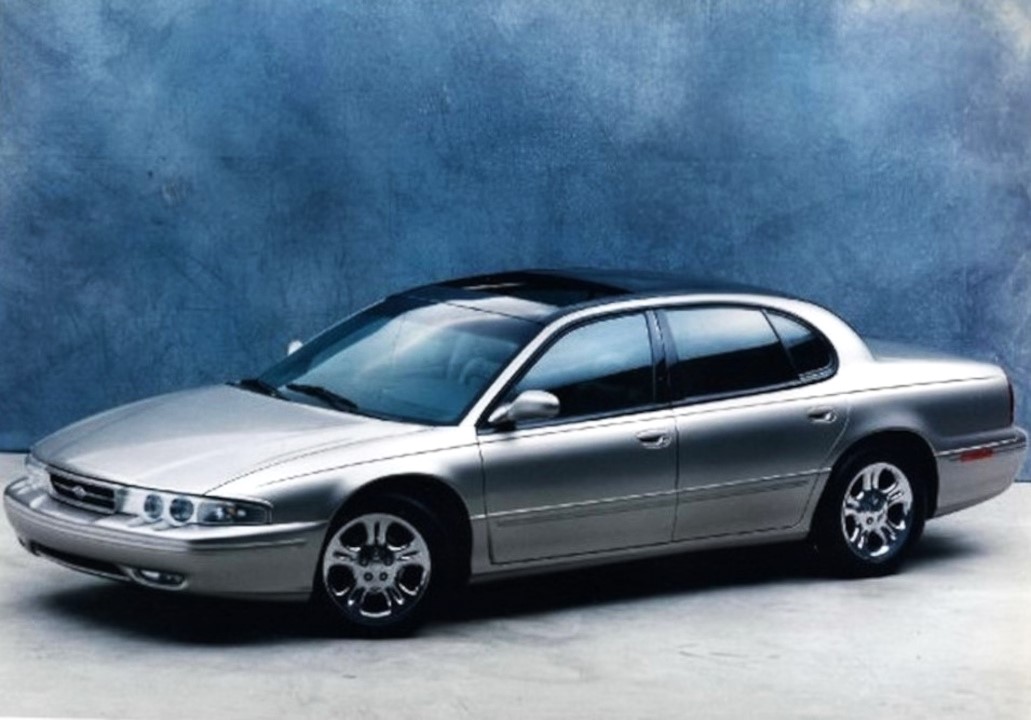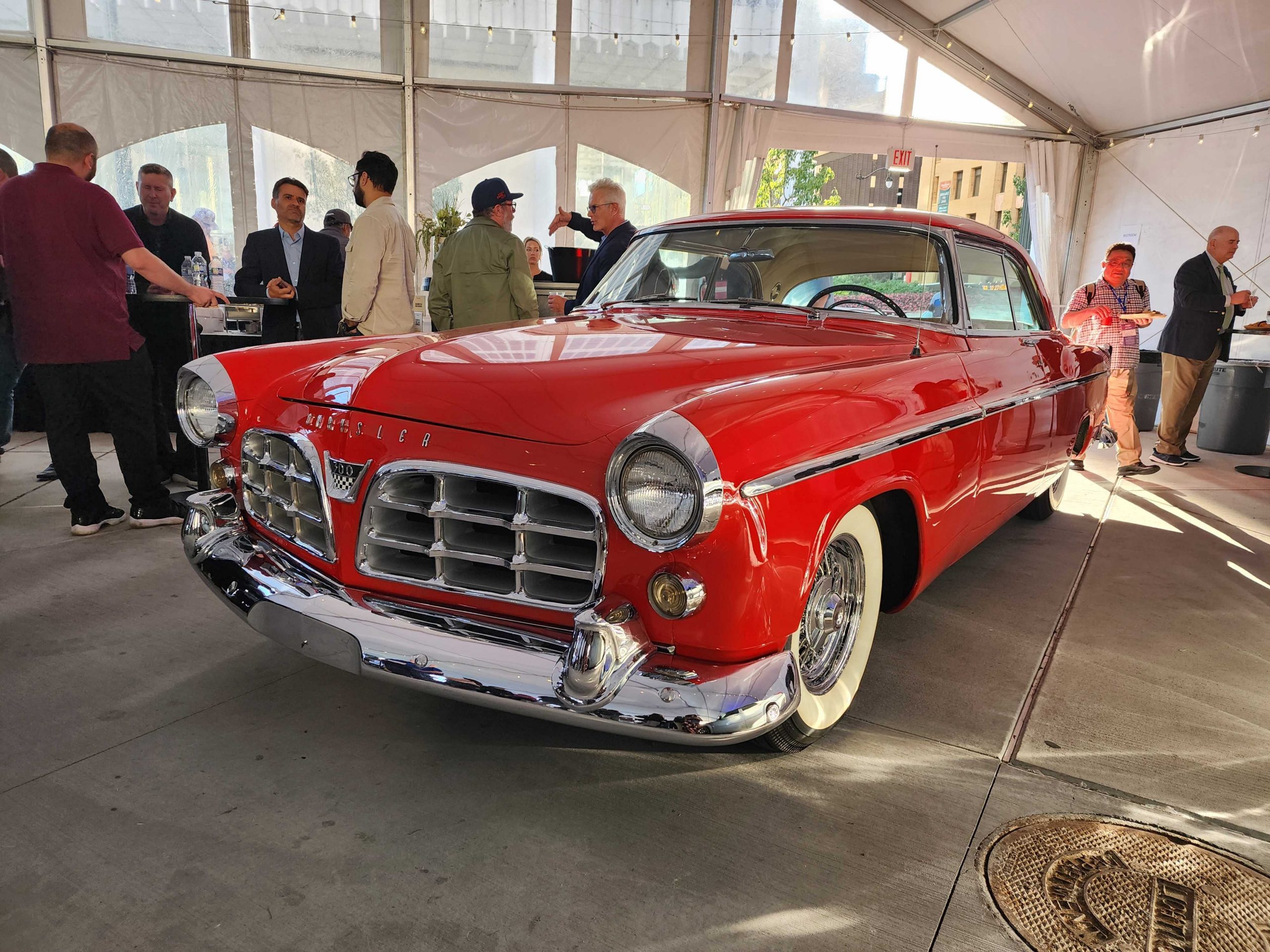This listing popped up on my feed this morning and I was stunned by what I was looking at. It looked like someone crashed their Chrysler New Yorker through a Pep Boys, coming out of the other side with shiny custom headlights and a new grille. But the headline of the listing said it was a prototype, and it’s a Chrysler 300 to boot. Wait, what? I clicked in to see what was going on. To explain my confusion, we have to flip back through several pages in our calendars. In two archived documents, Chrysler marks the start of its famed 300 in 1955. This first 300 (known internally as the C-300) got its name from the 331 cubic inch V8 under the hood that made 300 gross horsepower. Chrysler claimed this car to be America’s most powerful production car, and it set a record at Daytona after it hit 127.580 mph, or 7 mph faster than the nearest non-Chrysler. And this car wasn’t just fast, as it also came with a sport-tuned suspension and a leather interior. Chrysler goes on to note that given its $4,109 price (more expensive than the day’s $3,069 Corvette), it was nicknamed “The Banker’s Hotrod.” And these cars lived up to that nickname, too, as they found success on NASCAR circuits. The next year, Chrysler would introduce the first of the “Letter Series” with the 300B. Chrysler says a notable feature of the 1956 was an available three-speed manual transmission, which wasn’t available in the first 300. However, apparently, most buyers opted for the three-speed TorqueFlite automatic. That makes sense, given the luxury ambitions of the 300B. Chrysler would continue production of lettered 300 cars until 1965. By that time, Chrysler says, the raw power of the 300 Letter Series cars no longer had as much emphasis as the automaker had other performance vehicles to offer. At the same time, the automaker notes, it was also selling non-letter 300s. Between 1962 and 1971, the 300 Sport Series offered buyers a more affordable sport and luxury experience to the then-exclusive 300 Letter Series cars. In 1970, a performance model returned with the 300 Hurst. While not a letter car, it paired a leather interior with a 440 cubic inch V8 making 375 HP. And it was fairly exclusive as it was limited to a run of just 485 units. The 300 name would return again in 1979 in the Chrysler Cordoba as the “300 Special Edition” performance trim. Then Chrysler went a whole 20 years without a 300 until the 300M made its appearance in 1999. And of course, the 300 has survived into the present day, most recently evolving into the 300C. So, what’s going on with this 1993 concept car getting the 300 name? I searched Stellantis articles on 300 history and not a single one of them mentions this creation. Documents provided with the car indicate that its modifications came from the American Sunroof Company (a firm that’s taken part in great cars like the Buick GNX) under the headline of “Complete Development Capabilities.” It appears to have started life as a Chrysler LHS or New Yorker before getting outfitted into a luxury cruiser by ASC. Manufacturer-style photos like the one near the top of this post also come with the car in the sale. [Editor’s Note: I just want to communicate how important this car and its siblings on the LH Platform were at the time. These were the Chrysler “cab-forward” cars, with transverse [Edit: They’re not transverse. They’re longitudinal front-drive! How did I not know this?!] front-engines and a “cab forward” design that yielded lots of interior space. Allpar describes what that means, writing: Quality was higher than usual for Chrysler, and overall, the vehicles were state-of-the art in the way they were developed and manufactured. As Allpar puts it: This 300 concept here is a variation of the first model year of the LH platform (like Mercedes said, an LHS or New Yorker), a platform that welcomed its own 300, the 300M, but that came out six years after this concept car (in 1999). The point is: 1993 was a huge deal for this platform, and this particular concept was probably mind-blowing back in 1993. Oh how far it has fallen. -DT] The headlining feature for the concept, I think, is the front glass sunroof and rear moonroof. The expansive glass roof features a motorized sunshade. You can see the roof open in the profile shot near the top. ASC also added more with a unique front bumper, projector headlights, touring suspension, a unique grille, special cladding, taillights, wheels, and more. And the interior was finished in Italian leather. Power comes from a 3.5-liter V6, which in LH platform cars made 215 HP sent to the front wheels through an automatic transmission. The finished car was named the 300 and the seller claims that $145,000 was spent on bringing it to life. What’s unclear is if this is something that Chrysler teamed up with ASC to build, or if it’s just a one-off by ASC to show off its skills. A hint comes from the Detroit Free Press, which reported that ASC rolled into the 1993 Detroit Auto Show with a variety of concept vehicles, including this Chrysler 300 along with a GMC Sonoma with a targa roof and a touring edition of a Ford Crown Victoria. I reached out to Stellantis asking if Chrysler was involved, and thus far, a representative has told me that it could be a prototype, but they are looking into this question. I will update if the information changes. Apparently, the car’s had some sort of life after being a show car. It showed up for sale in 2010 at the Volo Auto Museum in Volo, Illinois with 330 miles on its odometer and a price of $25,998. It was still for sale at the museum in 2014 and 2015 for $21,998. Today, it’s for sale in Minot, North Dakota with 1,000 miles on the odometer. This time, it’s offered by dealer Pro Market Connections. Disappointingly, the photos provided for the current ad are the 12-year-old photos that Volo provided when it sold the car. I can’t imagine the car’s condition has changed much over the course of 12 years and just 670 miles, but I’m still curious. But if you’re the kind of person who wants to own a concept car so obscure that there’s not much documented history on it, the price is $35,000. Is it worth that much? I’m not sure. But you’ll get to say that you own a concept car!
Support our mission of championing car culture by becoming an Official Autopian Member. • The 2023 Chrysler 300C Is A Reborn SRT8 • Dodge Neon ACR Racing Champion Tells Us Why The First-Gen Neon ACR Was A Wolf In Economy Car Clothing • No Amount Of Money Is Too Much Money For This Vanilla-Pudding Chrysler Crossfire Chrysler had a very, VERY deep and ongoing relationship with ASC starting in the early 80’s. ASC did the engineering for the Daytona T-Tops. ASC did the engineering and ODMing for their sunroofs. ASC was contracted to design and produce certain exterior accessories and interior components. ASC helped with the LeBaron convertible. Ford EXP? That was them. Saab 900 convertible? Yep. And ASC was specifically contracted to do the 300C Helios convertible concept. So could Chrysler have contracted them to do some LH 300 concept work? Absolutely. They did it before, no reason to think they wouldn’t have done it again. Did they? Honestly, I would say there is basically no possibility of us ever getting a definitive answer. Untold reams of documents were destroyed during the Dumber-Chrysler years, ASC sold the concepts and development division to Roush in 2016, and basically closed up the OEM/ODM operations for good in 2017. Being at the 1993 NAIAS, early in the year, this concept had to also be a preview of the upcoming LHS & New Yorker, which trailed the other models by a model year, as much as it was to show off ASC. Further – to gauge reaction for a ‘sporty’ Chrysler sedan again. At that point, moreso than Dodge/Plymouth, the Chrysler brand specifically was still deep into wire wheels, landau roofs, button leather seating etc. – the Concorde was the first break from that. Even if the market had been quickly shifting away from that, they didn’t want to upset the existing customer base. OTOH, the fuel economy was middling decent and the back seat was NBA sprawling big (they had to sprawl, the headroom didn’t match the foot room and the bench was a bit low). The front seat held you up in front of the wheel, but that’s all I remember of it. It deprecated as fast as a BMW and parts were nearly expensive. My wife loved it. Their transmission didn’t help either. And of course something is broken on it because Chrysler LOL of course some trim around the headlights would be missing. They look like off-the-shelf Hella projectors or something And it is probably easier to get headlight trim for a Yugo than it is for those random 90s aftermarket headlights. The project was not commissioned or funded by Chrysler. ASC had the practice of building such show cars as a means of showing capability as a supplier. Mike Alexander (of Alexander Brothers fame) led the ASC Technical Center and Chris Ito led the design studio at the time. It was a fantastic place to work at the time, under such incredible leadership. Thanks, Kipewing I love this community! That said, I do like the look of this, as with all the other longitudinal FWD Pentastars. My favorite real one would have to be the 300M, though its preceding Eagle Vision counterparts were cool, too. (And if Toyota offered a different take on the RAV4, I’d definitely be looking at that instead of the “angry mechanical catfish” grille they currently sell.)







